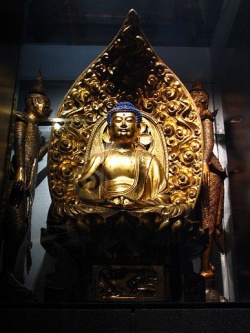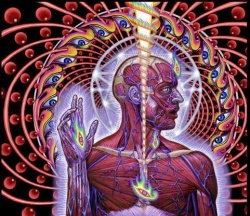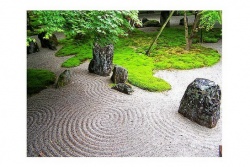The Surangama Sutra - The Volitions Skandha
"Ananda, as the disciples practice samadhi and free themselves from the skandha of conception, ordinary delusory thinking disappears. Now they will be constant in waking and sleeping, and their consciousness will become as empty and pure as a clear blue sky, no longer subject to the shadow of coarse sense impressions. The earth together with its mountains and rivers seem as if they are reflections in a bright
mirror. Impressions come without sticking and leave without a trace. Hence, the practitioner is able to react to externals unfettered by old habits. Now the ultimate reality and source of creation and destruction are fully revealed. They will be able to see the twelve classes of living things in all their variety throughout the ten directions as essentially sharing the same state of life, although they do not yet understand the source of their existence. In this state of mind things appear as shimmering mirages that disturb the mind's purity, and this explains the ultimate cause of the illusion of sense perception. This is called the skandha of volition, or action that passes on its effects. If these mirage-like disturbances of our purity are allowed to revert to their original nature, and this original nature is allowed to revert to its original purity, then with the purification of our original habits, they become like the passing of ripples that leave behind clear water. This then may be called the cessation of the skandha of volition. In this way a man may transcend the defilements that afflict living things during the kalpa of impurity. If we examine the origin of these defilements, the root cause is subtle erroneous thinking.
1. "Ananda, all of the disciples fixed in samadhi, whose minds are concentrated and clear and are no longer troubled by the ten classes of heavenly maras, can now look deeply into the origin of living things. Having discovered the origin of creation and destruction and observing the continuous subtle disturbance in this clear state, if they then begin to indulge in misguided calculation and discrimination, they will fall into two theories of the nonexistence of causality.
The first is the practitioner who concludes that phenomena appear with no fundamental cause. Why is this? Because at this level they have already obliterated their life impulse, and based on the eight hundred powers of the organ of vision, they perceive all living things throughout the eighty thousand kalpas as reincarnating over and over. Because they see nothing beyond these eighty thousand kalpas, they come to the conclusion that all living things within the ten directions over the eighty thousand kalpas arise without cause, and as a result of this exercise of discrimination they miss universal knowledge and fall into an unorthodox path that obscures their bodhi-nature.
The second case is the practitioner who concludes that results appear with no fundamental cause. Why is this? Because this man has examined the root nature of life and discovered that human beings give birth to human beings and realized that birds give birth to birds; crows are always black and cranes always white. Human beings are upright and animals horizontal. Whiteness is not produced from washing, and blackness is not produced by dyeing. For eighty thousand kalpas this has never varied and will be so even after my present body is no more. Finding no such thing as bodhi-nature in this process, he wonders how such a thing could exist and concludes that all phenomena are fundamentally without cause. Calculating and discriminating in this manner, he misses universal knowledge and falls into an unorthodox path that obscures his bodhi-nature. These two theories of the nonexistence of causality are the first heresy.
2. "Ananda, all of the disciples fixed in samadhi, whose minds are concentrated and clear can no longer be troubled by maras. In looking deeply into the origin of all classes of living things and observing the continuous subtle disturbance that operates ceaselessly, if they exercise their powers of discrimination, they will fall into the four theories of universal permanence.
The first is the practitioner who looks deeply into the nature of the mind and its objects and finds that both are without cause. In his meditative practice he becomes aware that during twenty thousand kalpas all living things within the ten directions experience birth and death, and that nothing being lost within this cycle, he takes this to indicate permanence.
The second is the practitioner who looks deeply into the four primal elements--earth, fire, water, wind--and finding that these elements survive in spite of the ceaseless process of creation and destruction affecting all living things in the ten directions for forty thousand kalpas, takes this to indicate permanence.
The third is the practitioner who looks deeply into the six indriyas--eye, ear, nose, tongue, body, and mind--the manas, or faculty of intelligence, and the retention of memories and concludes that the source of consciousness is eternal. Through practice he realizes that during eighty thousand kalpas living things are never lost but ceaselessly cycle, and in thinking deeply on the nature of their continuation, he takes this to indicate permanence.
The fourth kind of practitioner has already exhausted the source of the third skandha, or conception, and concludes that the flow of life has ceased, and that the concept of creation and destruction being obliterated in his mind, he naturally comes to the conclusion that there is no creation and destruction and that this constitutes permanence. From this conception of permanence he misses the Buddha's universal nowledge and falls into an unorthodox path that obscures his bodhi-nature. These four theories of wrong permanence are the second heresy.
3. "Again, all of the disciples fixed in samadhi, who concentrate their minds, will no longer be taken advantage of by the maras. Now looking deeply into the root of the various classes of living things, and observing the continuous subtle disturbance that operates ceaselessly, if they exercise their powers of calculation and discrimination, they will fall into one of the four kinds of perverse views regarding permanence and impermanence.
The first is the practitioner who observes that his own subtly clear mind pervades the ten directions, and takes this to be his own spiritual self. From this he concludes that since his own self fills the ten directions, and since within this luminous and immutable noumenal self all living things are born and die, therefore the nature of mind is permanent, whereas that which is born and dies is impermanent.
The second type of practitioner does not look into his own mind, but contemplates the countless realms of the ten directions and concludes that those that are destroyed in the kalpa of destruction are impermanent and those spared are permanent.
The third type of practitioner also observes his own mind and finds that it is composed of subtle particles. These circulate throughout the ten directions, and without changing in their fundamental nature, are capable of causing the body to instantly exist or not exist. Its indestructible nature he calls the permanence of the self, and everything that is born and dies and flows from this self he calls impermanent.
The fourth type of practitioner realizes that the skandha of conception has been exhausted, but observes the ceaseless flow of the skandha of discrimination and concludes that this represents permanence. Since his first three skandhas--form, sensation, and conception--have already been exhausted, he calls them impermanent. By thus discriminating between permanence and impermanence, he falls into unorthodox paths and obscures his bodhi-nature. These four theories of wrong permanence are the third heresy.
4. "Again, all of the disciples fixed in samadhi, whose minds are concentrated can no longer be troubled by the maras. Now looking deeply into the origins of living things and observing the source of the continuous subtle disturbance in this clear state, if they begin to make discriminations on the basis of time, perception, self and other, and creation and destruction, they will fall into four types of theories regarding finitude and infinity.
The first is the practitioner who calculates that the source of life flows on without end. That portion belonging to the past and future he considers finite, and the continuous flow of his present mind he calls infinite.
The second is the practitioner, who contemplating eighty thousand kalpas and beholding all living things therein concludes that since he has no knowledge of the period before the eightly thousand kalpas, it is infinite. That place where all living things dwell he calls finite.
The third is the practitioner who calculates that his own knowledge is universal and of an infinite nature because all other people appear within his field of knowledge. However, because their knowledge does not appear in his mind, he concludes that they do not possess infinite minds, but are finite in nature.
The fourth practitioner looks deeply into the fourth skandha, or action that passes on its effects, and finds it empty. Based on his observation, he concludes that within each living body there exists half creation and half destruction, and that everything in the world is half finite and half infinite.
Thus all of these practitioners who discriminate between the finite and the infinite fall into an unorthodox path and obscure their bodhi-nature. These four theories of finitude and infinity are the fourth heresy.
5. "Continuing, all of the disciples fixed in samadhi, whose minds are concentrated are no longer troubled by the maras. Now, looking deeply into the origin of living things and observing the source of the continuous subtle disturbance in this clear state, if based on his own knowledge he exercises his powers of discrimination, he will fall into four categories of erroneous views concerning the existence of an undying entity.
The first type of practitioner looks into the origins of the process of transformation; where he observes change he calls it transformation, and where he observes continuity he call it constancy. What he is able to observe he calls creation; what he does not observe he calls destruction. That which preserves its nature through the process of transformation he calls increase; that which is discontinuous through the process of transformation he calls decrease. Wherever creation appears he calls it existence; wherever disappearance occurs he calls it nonexistence. This is all the result of exercising his powers of discrimination. When approached by seekers for his explanation, he replies: 'At this moment I am simultaneously created and destroyed; I exist and do not exist; I increase and decrease.' With these kinds of wild statements he confuses his listeners.
The second type of practitioner carefully scrutinizes his mind, and finding that it has no locus, concludes that its existence cannot be proven. When asked to explain his viewpoint, he answers with the one word 'nonexistence.' Apart from nonexistence, he has nothing to say.
The third type of practitioner carefully scrutinizes his mind, and finding that its locus is everywhere, concludes that he has proof of its existence. When asked to explain, he answers with the one word 'existence.' Apart from existence, he has nothing to say.
The fourth type of practitioner sees both existence and nonexistence, but because of this duality, his mind is confused. When asked to explain his viewpoint, he answers: 'Existence includes nonexistence, but nonexistence does not include existence,' and all manner of nonsense that defies reason. By discriminating in this way, he creates confusion and nonsense, and thus falls into heresy and obscures his bodhi-nature.
These four absurd notions concerning the undying and related false theories are the fifth heresy.
6. "Continuing, all of the disciples fixed in samadhi, whose minds are concentrated, are no longer troubled by the maras. Now, looking deeply into the origin of living things and observing the continuous subtle disturbance in this clear state, and in the midst of the infinite life stream, if the practitioner begins to exercise his faculty of discrimination, he will fall into the error of believing that after death our form remains.
He may stubbornly cling to this body and claim that his physical form is identical with his self.
Or he may feel that his all-encompassing self contains all realms and claim that the self possesses form.
Or he may feel that physical appearances that present themselves follow the self through its cycles and claim that form belongs to the self.
Or he may believe that the self is a property of the flow of samskara (form) and claim that the self resides within form.
All of the above arises from the belief that form continues to exist after death. In this way, the deluded practitioner goes round and round, postulating sixteen types of form. Or he may conclude that fundamentally mental suffering and bodhi coexist without contradiction. Because of the erroneus view that form exists after death, he falls into an unorthodox path and obscures his bodhi-nature. The theory that among the five skandhas form continues to exist after death is the sixth heresy.
7. "Continuing, all of the disciples fixed in samadhi, whose minds are concentrated are no longer troubled by the maras. Now, looking deeply into the origin of living things and observing the source of the continuous subtle disturbance in this clear state, and after first eliminating the skandhas (form, sensation, and conception), if the practitioner continues to exercise the faculty of discrimination, he will fall into the belief that after death there is no form, and hence his mind will be unbalanced. Seeing the skandha of form vanish, physical appearance no longer has a cause; seeing the skandha of conception vanish, the mind is without attachments; and knowing that the skandha of sensation has vanished, there are no longer any aggregates. Thus, although the skandhas have disappeared, even though life remains, without sensation and conception, it is the same as grass and trees. If form does not even exist in the present, how then can it exist after death? As a result, he speculates that form does not exist after death. Reasoning in this way, he posits a theory of eight aspects of formlessness. Hence, he asserts that nirvana is without cause and effect, everything else being merely names and subject to annihilation. In this way, he concludes that nothing survives after death, and thus falls into an unorthodox path and obscures his bodhi-nature. This theory that within the five skandhas form does not exist after death is the seventh heresy.
8. "Continuing, all of the disciples fixed in samadhi, whose minds are concentrated, are no longer troubled by the maras. Now looking deeply into the origin of living things and observing the source of the continuous subtle disturbance in this clear state, they are still subject to the skandha of volition. Having seen the annihilation of the skandhas of form, sensation, and conception, they may conclude that existence and nonexistence automatically cancel each other. This type of practitioner falls into the belief that after death neither existence nor nonexistence are valid and thus puts forth nonsensical theories. When subject to the skandhas of form, sensation, and volition he believed they existed, but on further penetration concludes they did no exist. Now in the midst of the stream of the skandha of volition, he sees non-existence as not nonexistence. Continuing in this vein, he penetrates the realm of the
four skandhas and concludes that the eightfold negation of form is arbitrary, that it can equally be said that after death form exists or does not exist, and that the skandha of volition is likewise in a state of constant flux. Thus he concludes that he has awakened to the truth that existence and nonexistence are both invalid, the real and the unreal ungraspable. From this he concludes that there is nothing that can be asserted about death, and that all is murky and nothing can be said of it. Thus he falls into an unorthodox path and obscures his bodhi-nature. This theory that within the five skandhas nothing can be asserted about our state after death is the eighth heresy.
9. "Continuing, all of the disciples fixed in samadhi, whose minds are concentrated are no longer troubled by the maras. As they look deeply into the origins of living things and observe the source of the continuous subtle disturbance in this clear state, if they exercise the faculty of discrimination may determine that nothing exists after our final end. This type of practitioner falls into the theory of the seven annihilations. He may conclude that the body is destroyed, or that desire is destroyed, or that suffering is destroyed, or that joy is destroyed, or that indifference is destroyed. Continuing in this vein, he sees these seven aspects as thoroughly and irrevocably annihilated. For his belief in annihilation after death he falls into an unorthodox path and obscures his bodhi-nature. This theory that within the five skandhas all is annihilated after death is the ninth heresy.
10. "Continuing, all of the disciples fixed in samadhi, whose minds are concentrated are no longer troubled by the maras. As they look deeply into the origin of living things and observes the continuous subtle disturbance in this clear state, if they exercise the faculty of discrimination may conclude that there is existence after death. This type of practitioner will fall into the false theory of the five conditions of nirvana. He may conclude that the realm of desire is the true foundation of nirvana because of his delight in contemplating the perfect clarity of the six devaloka heavens of sensual pleasure; or he may conclude that the first dhyana heaven is the true foundation of nirvana because it is free of worldly cares; or he may conclude that the second dhyana heaven is the true foundation of nirvana because the mind is without suffering; or he may conclude that the third dhyana heaven is the true basis of nirvana because it is full of joy; or he may conclude that the fourth dhyana heaven, where both suffering and happiness are no more and one is no longer subject to birth and death in samsara, is the true basis of nirvana. Thus he mistakes samsaric heavens for the true state of nonaction and takes refuge in these five heavens as the ultimate basis of nirvana. Continuing in this vein, he will conclude that these five manifestations constitute true nirvana and will thus fall into an unorthodox path and obscure his bodhi-nature. This theory of the five false manifestations of nirvana within the five skandhas is the tenth heresy.
"Ananda, it is these ten kinds of wild interpretations of dhyana, which are all due to the interaction of the skandha of volition with the practice of meditation, that causes them to have these realizations. Living things are stubborn and deluded and unable to assess their own level of accomplishment. When they experience these phenomena, they misinterpret them and claim to have reached sainthood. For violating
the commandment against lying, they fall into eternal hell. You disciples must take my words, and after I pass into nirvana, transmit them during the dharma-ending age in order to awaken them to this truth, and so that the maras of the mind will not cause them to bring retribution upon themselves. They must be vigilant and wipe out perverse views. They must train their bodies and minds to awaken to the truth and not stray from the supreme Tao. They must refrain from wishful thinking or complacency after a little progress, but must be models of the highest enlightenment and purity.






